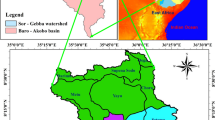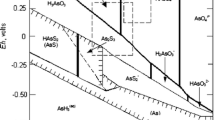Abstract
An elevated concentration of uranium in the water of some springs in the Permo-Triassic sedimentary rocks of the Visok region, south-eastern slopes of the Stara Planina, eastern Serbia, is interpreted based on geological, hydrogeological and hydrochemical data. Uranium concentration in groundwater was first examined whilst exploring for uranium minerals as an energy resource. The purpose of a later hydrogeological investigation was assessment of a safe drinking water supply to a planned ski-centre hotel. The maximum contaminant level for uranium, recommended by the World Health Organization (WHO), is 15 μg/L. This work reviews and interprets the naturally elevated uranium in springs from the Permo-Triassic sediments of Visok, focusing on geological, hydrogeological, hydrogeochemical and other factors of uranium contamination. Uranium distribution in groundwater from Permo-Triassic aquifers was studied by taking groundwater, spring sediment and rock samples. The varied mobility of uranium depends largely on lithology, which also controls the chemistry of groundwater. The investigation results have shown that sulfate–calcium groundwater is a suitable facilitator of uranium mobility with a high migration coefficient of 0.77. Uranium concentrations in this water were up to 41 μg/L, with a Sa/Sr mass ratio of around 20, and a mineral content of about 0.5 g/L. The hydrochemistry was characteristically transitional Eh and pH neutral. Elevated uranium in groundwater has been reported globally and may be compared.





Similar content being viewed by others
References
Andjelkovic, J., Krstic, B., Ciric, A., Martinovic, D., & Bogdanovic, P. (1975). Base geological map at 1:100,000 Pirot Sheet and textual explanation. Belgrade: Federal Geological Institute.
Antonovic, A. (1980). The Red Permian Sandstone Formation in Yugoslavia and other countries. Proceedings: Symposium on regional geology and paleontology (pp. 347–356). Belgrade, December.
Asikainen, M. (1981). State of disequilibrium between 238-U, 234-U, 226-Ra and 222-Rn in groundwater from bedrock. Geochimica et Cosmochimica Acta, 45, 201–206.
Beaty, R. D. (1988). Concepts, instrumentations and techniques in atomic absorption spectrophotometry. Norwalk: PerkinElmer, Inc.
Betcher, R. N., Gascoyne, M., & Brown, D. (1988). Uranium in groundwater of southeastern Manitoba, Canada. Canadian Journal of Earth Science, 25, 2089–2103.
Burton, W. C., Plummer, L. N., Busenberg, E., Lindsey, B. D., & Gburek, W. J. (2002). Influence of fracture anisotropy on ground-water ages and chemistry, Valley and Ridge Province, Pennsylvania. Ground Water, 40, 242–257.
Clesceri, L. S., Greenberg, A. E., & Eaton, A. D. (1995). Standard methods for the examination of water & wastewater (19th ed.). Washington: American Public Health Association.
Durrance, E. M. (1986). Radioactivity in geology—principles and applications. Chichester: Ellis Horwood.
Gertik, S. (1988). Factors controlling uranium mineralization in Variegated Sandstone of Stara Planina. Radovi Geoinstituta, 22, 33–41.
Gertik, S. (1989). Sedimentological–geochemical characteristics of variegated sandstone and factors controlling uranium mineralization. Radovi Geoinstituta, 23, 19–26.
Hollocher, K., & Yuskaitis, A. (1993). Chemical composition of surface and high uranium well water, Lake Sunapee area, New Hampshire. Northeastern Geology, 15, 159–169.
Jankovic, S. (1981). Mineral resources—origin of ore deposits. Belgrade: Faculty of Mining and Geology.
Kim, Y. (1999). The concentrations and distributions of U and Th in Paleozoic aquifers surrounding the Llano Uplift area, central Texas: Application to the sources of Ra and Rn in ground-water. Geosciences Journal, 4, 201–211.
Kinze, M. (2002). Dose limits and maximum concentration limits (MCLs) for radionuclides—Implication on remediation of uranium mining and milling facilities in Saxony, Germany. Paper presented at the Uranium in the Aquatic Environment: International Conference Uranium Mining and Hydrogeology III and the International Mine Water Association Symposium, Freiberg, September.
Kovacevic, J. (1997). Uranium metallogeny in Permo-Triassic sedimentary rocks of Stara Planina. M.Sc. thesis, University of Belgrade Faculty of Mining and Geology.
Kovacevic, J. (2006). Metallogeny of Stara Planina. Dissertation, University of Belgrade Faculty of Mining and Geology.
Nikic, Z. (2003). Hydrogeological analysis of the low flows formation and regionalization. Belgrade: Zaduzbina Andrejevic.
Nikic, Z., Kovacevic, J., & Radosevic, B. (2002). Uranium content in ground water in Stara Planina Triassic sediments. Paper presented at the Uranium in the Aquatic Environment: International Conference Uranium Mining and Hydrogeology III and the International Mine Water Association Symposium, Freiberg, September.
Nikic, Z., Kovacevic, J., & Radosevic, B. (2005). Changes in the effluents from abandoned uranium mines near Kalna. In J. B. Merkel & A. Hasche-Berger (Eds.), Uranium in the Environment: Mining Impact and Consequences (pp. 765–772). Berlin: Springer.
Perelman, A. I. (1972). Geochemistry of elements in the zone of hypergenesis. Moskva: Nedra.
Perkins, E. H., & Gunter, W. D. (1999). SOLMINEQ.GW. Alberta: Geoscience.
Radosevic, B., Kovacevic, J., & Jovic, V. (2002). Natural occurring uranium in Serbia and possible environmental effect. Journal of Environmental Protection and Ecology, 3, 706–718.
Romberger, S. (1984). Transport and deposition of uranium in hydrothermal systems at temperatures up to 300°C. In De Vivo, F. Ippolito, G. Capaldi, & P. R. Simpson (Eds.), Geochemical implications: Uranium geochemistry, mineralogy, geology, exploration and resources (pp. 12–17). London: Institution of Mining and Metallurgy.
Seiler, R. L. (2004). Temporal changes in water quality at a childhood leukemia cluster. Ground Water, 3, 446–455.
Sherman, H. M., Gierke, J. S., & Anderson, C. P. (2007). Controls on spatial variability of uranium in sandstone aquifers. Ground Water Monitoring & Remediation, 27, 106–118.
Sinha, D. K., Shrivastava, P. K., Hansoti, S. K., & Sharma, P. K. (1997). Uranium and radon concentration in ground water of Deccan Trap country and environmental hazard in Keolari-Nainpur area, Seoni-Mandla District, Madhya Pradesh. Special Publication Series—Geological Survey of India, 2, 115–121.
Tricca, A., Porcelli, D., & Wasserburg, G. J. (2000). Factors controlling the ground water transport of U, Th, Ra and Rn. Proceedings of the Indian National Academy of Sciences, 109, 95–108.
U.S. EPA (1981). Manual of ground-water quality sampling procedures. Method 600/2-81-160. Virginia: National Technical Information Service, Springfield.
U.S. EPA (1997). Methods and guidance for the analysis of water. Method 821/C-97-001. Virginia: National Technical Information Service, Springfield.
U.S. EPA (2000). Technical fact sheet: Final rule for (non-radon) radionuclides in drinking water. EPA 815-F-00-013. http://www.epa.gov/safewater/rads/technicalfacts.html.
World Health Organization (2004). Guidelines for drinking water quality, 3rd ed, vol. 1, Recommendations. http://www.who.int/water_sanitation_health/dwq/GDWQ2004web.pdf.
Zouridakis, N., Ochsenkuhn, K. M., & Savidou, A. (2002). Determination of uranium and radon in potable water samples. Journal of Environmental Radioactivity, 61, 225–232.
Acknowledgement
This research work is part of Project 146021 (Geological and Ecotoxicological Investigations in Identification of Geopathogenic Zones of Toxic Elements and Natural Radioactivity in Drinking Water) funded by the Serbian Ministry of Science and Environment. Geological investigation in the Visok region was funded by the Ministry of Mineral and Energy Resources of Serbia; it is one of various multidisciplinary projects aimed at the discovery of uranium mineral deposits for energy production.
Author information
Authors and Affiliations
Corresponding author
Rights and permissions
About this article
Cite this article
Nikic, Z., Kovacevic, J. & Papic, P. Uranium in the Groundwater of Permo-Triassic Aquifers of the Visok Region, Stara Planina, Eastern Serbia. Water Air Soil Pollut 192, 47–58 (2008). https://doi.org/10.1007/s11270-008-9633-z
Received:
Accepted:
Published:
Issue Date:
DOI: https://doi.org/10.1007/s11270-008-9633-z




